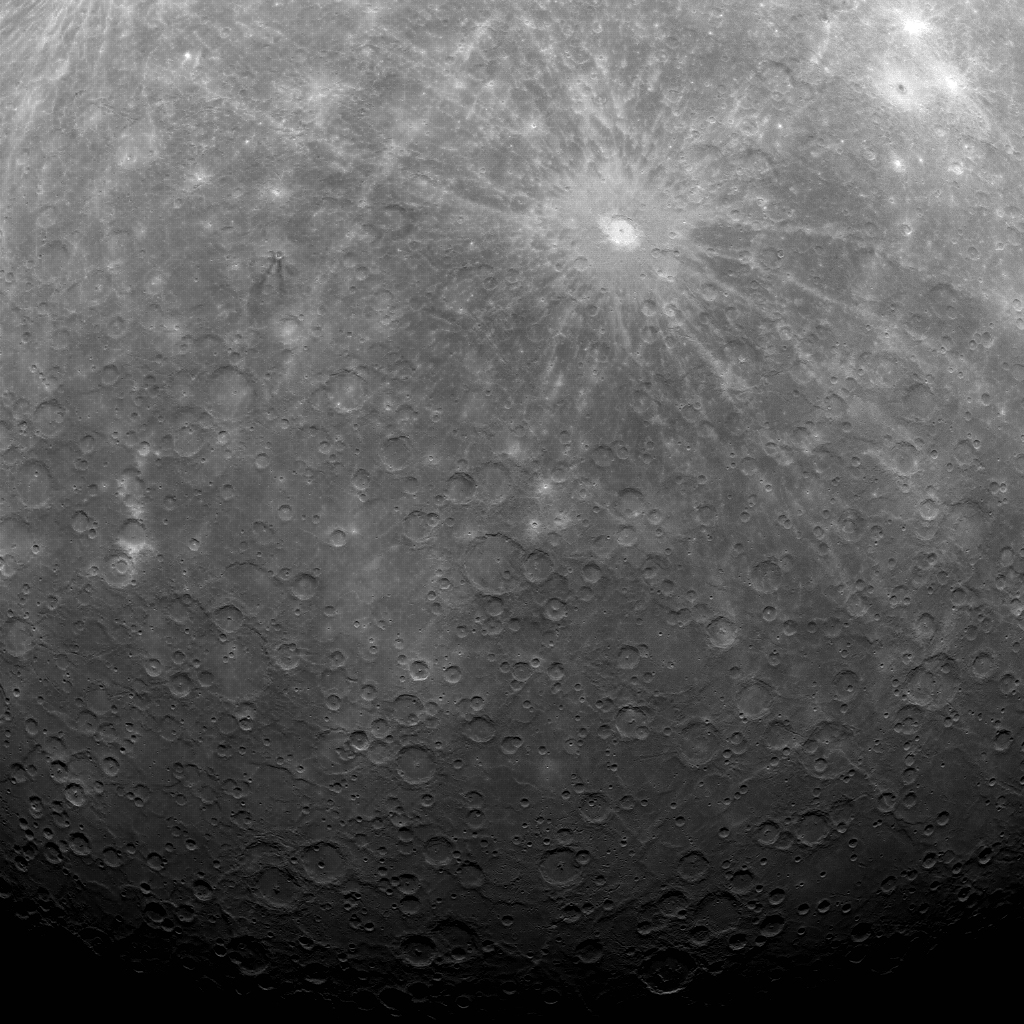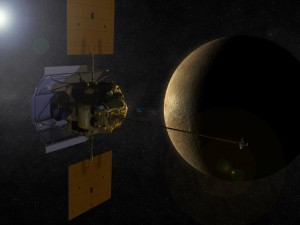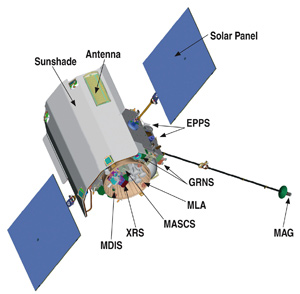NASA MESSENGER: Mercury has an orbiter (37 yrs after Venus)
A Valentine night with Tempel-1 ?
February 15, 2011Today the Allen Array Telescope is hibernating
April 22, 2011I mentioned in previous posts in my blog significant results obtained by MESSENGER, the NASA Discovery mission which had three flybys with the inner planet Mercury. Today after a successful orbit insertion on March 18, the spacecraft delivered its first science picture.
Even if I am not involved in the study of Mercury, the MErcury Surface, Space ENvironment, GEochemistry and Ranging (MESSENGER) NASA mission always fascinated me. The mission is part of the NASA Discovery program, a low cost space mission program and is managed by the JHU-APL that I visited beginning of January 2011. I found out that this mission which aims at exploring the inner frontier of our solar system, also involves a large team of remarkable and motivated scientists who were anxious to see their spacecraft in orbit around Mercury.
I described extensively the mission and the first significant scientific results in a post written in December 2009 shortly after the AGU Fall Conference. It is remarkable that with three flyby-s (in January 2008, October 2008, and one partially successful in September 2009), the team already collected interesting data which shined light on the capabilities of the mission to provide clues on its key science objectives. We, therefore, hoped that on March 18, after traveling in cold space for 2,416 days on a trajectory with a length of 7.9 billion of km (53 Astronomical Units, more than the distance between the Sun and Pluto), the MESSENGER would be indeed the first spacecraft to rendezvous the planet Mercury.
The orbit Insertion event could be watched live on NASA TV and by webcast. Shortly after the scheduled time on March 18 at 00:45 UT, the APL team confirmed that the spacecraft successfully was orbiting the planet in a proper orbit. It is not a trivial task to rendezvous a planet, since the insertion is done automatically, consequently the spacecraft orbit and all the maneuvers have to be carefully planned in advance. The recent Akatsuki failure, a JAXA mission which could not rendezvous the planet Venus, is a strong reminder of the difficulty of this task.
The planet Mercury is the last terrestrial planet to have an orbiter. Sputnik I was the first orbiter for Earth in 1957, our moon had its orbiter in 1966 (Soviet probe Luna 10), Mars in 1971 (US Mariner 9), Venus in 1975 (Soviet probe Venera 9). 37 years later, we finally give to our inner planet all the attentions that it deserved to be properly understood.
MESSENGER orbiter is currently describing a very elliptical orbit ranging from 200km to 15,000 km above the planet surface. Its nominal mission should last 1 year with a possible extension if the spacecraft and its instruments are still working well despite Mercury harsh environment. The spacecraft will use its suite of instruments to map Mercury surface and its composition, measure its magnetic field, determine the characteristics of its tenuous atmosphere, and its internal structure. The spacecraft is still being checked and the nominal mission should start on April 4.
 Today, March 29 2011, the science team posted on their website the first image of Mercury taken by the orbiter. An image from the visible wide angle camera (WAC) instrument which was captured on March 29 at 5:20 am EDT, was the first one received by the team using X-band transmission at a rate of 10-100 kb/s (slightly faster than a 56 kb modem) . More data are stored in a 6 Gb hard disk on board the spacecraft, so we should expect to see more images very soon.
Today, March 29 2011, the science team posted on their website the first image of Mercury taken by the orbiter. An image from the visible wide angle camera (WAC) instrument which was captured on March 29 at 5:20 am EDT, was the first one received by the team using X-band transmission at a rate of 10-100 kb/s (slightly faster than a 56 kb modem) . More data are stored in a 6 Gb hard disk on board the spacecraft, so we should expect to see more images very soon.
As I discussed in my previous post, the Mercury mapping is not finalized after three flybys and the missing part of the map are mostly the pole. The inclination of MESSENGER orbit allows the spacecraft to see this missing part of the planet surface. The main feature on this image is an impact crater called ‘Debussy’ which was discovered from radar observations in 1969 (planetocentric coordinate 33.9°S 347.5°W). One of the scientific objectives of the orbiter is to image the poles of the planet which are permanently in twilight (due to its low inclination of 7 degrees). The team expect to detect ice on floor of craters which are never directly illuminated by the sun (with an estimated temperature lower than 100 K (-280 F,-173 C)). Radar observations published in 1992 suggested the presence of polar ice.
The MESSENGER mission is about to be fully operational. Soon we will get more data about Mercury that we could even envision a few years ago. More data & more images mean that there will be more discoveries and a better understanding of the formation and evolution of the inner planet of our solar system. So stay tuned, I can predict that we will hear about Mercury quite often over the next 2 years.
Clear Skies,
Franck M.





1 Comment
Extra cet article. Clair, précis et bien à la portée dudit amateur. Merci… C’est aujourd’hui que sa principale mission commence… Que de chemin parcouru depuis Spoutnik I.